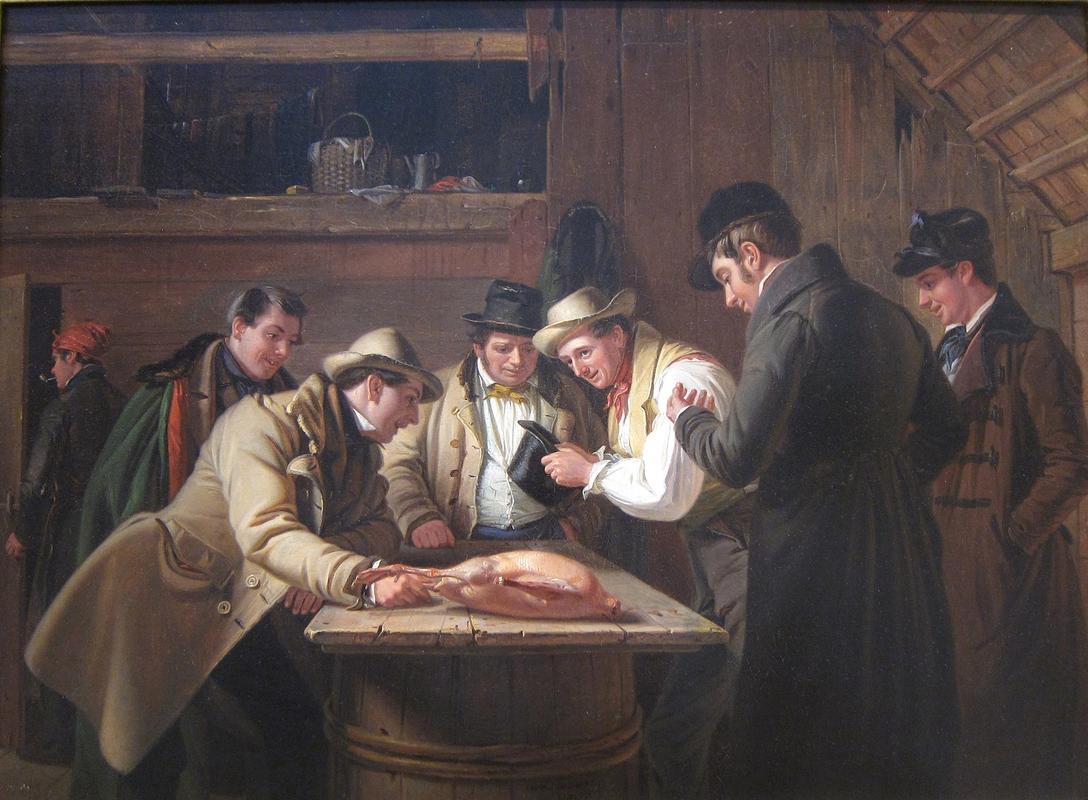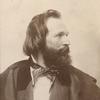More about The Raffle

Sr. Contributor
Everyone loves a raffle, right? Well, maybe if you’re the winner, but even if you don’t win, the money is usually going to support a cause or an organization - at least that’s often the case with raffles as we know them today.
Back in the 19th century, however, the raffle was a form of gambling where, in this case, the player was just trying to win some food for the family. A raffle featuring a goose or a turkey as the prize were popular at the time, although when the raffle was held in a tavern, as they often were, the activity might be seen as a bit seedy. Take the raffle depicted in William Sidney Mount’s The Raffle (Raffling for the Goose), in the Metropolitan Museum’s collection, which probably took place in the back room of a bar. The hat in the man’s hands likely contained raffle tickets, though some versions of the raffle used pennies tossed in the hat instead of paper tickets. Mount’s paintings often portrayed people as wholesome, not the types associated with sleazy gambling in a bar, and the men in the painting seem to reflect that, except maybe for the shady looking dude heading out the back door for a smoke.
Participating in a raffle back then could even get one arrested; the New York Sun of 1891 outlines the case of an unfortunate councilman who wouldn’t leave the game when ordered to do so by a police officer. The somewhat tongue-in-cheek article describes men who are “unable to resist the seductiveness of a turkey raffle,” and explains that some may see “turkey raffling not as gambling but a spirited method for the distribution of food products.” The art of the spin has been around for a while, apparently.
Mount painted The Raffle during the winter of 1837, and noted that, to prevent his “plate of paints” from freezing, he had to bring them back to his room every night. Raffle was commissioned by a lawyer named Henry Brevoort; according to Mount’s notes, the price of the painting was $250, but Brevoort gave him $50 extra because he felt Mount did not charge enough. It seems that not long after Mr. Brevoort took possession of the piece, it was sold to another lawyer, Marshall O. Roberts for the whopping price of $400.
Several years later, in 1853, Mount wrote to Roberts asking for a loan of the painting to display at the “Exhibition of the Industry of All Nations,” a World’s Fair held in New York. Imagine Mount’s surprise when Roberts turned down his request, stating that since he had paid “a very high price for the picture,” and was building a gallery to display his art collection, he just couldn’t loan his art out, as that would be to his “own disadvantage.” Sounds a bit selfish, but Mount apparently did not press the issue. The refusal to loan it may have been even more of a shock to Mount because Brevoort had previously loaned the painting to the twelfth annual exhibition of the National Academy. Roberts did throw him a bone though; he generously invited Mount to visit the gallery upon its completion.
Sources
- Boys, Bowery. “Turkey Raffles Were 19th Century Versions of Bar Trivia Nights.” The Bowery Boys: New York City History, January 14, 2015. https://www.boweryboyshistory.com/2013/10/turkey-raffles-were-19th-cent….
- Colbert, Charles. ""Fair Exchange No Robbery": William Sidney Mount's Commentary on Modern Times." American Art 8, no. 3/4 (1994): 29-41. http://0-www.jstor.org.pacificatclassic.pacific.edu/stable/3109170.
- Feld, Stuart P. ""In the Midst of 'High Vintage'"." The Metropolitan Museum of Art Bulletin 25, no. 8 (1967): 292-307. doi:10.2307/3258356.
- Frankenstein, Alfred V., and William Sidney Mount. Painter of Rural America: William Sidney Mount, 1807-1868. Washington, D.C.: Printed by H.K. Press, 1968.
- Gardner, Albert Teneyck. "The First Thirty Years." The Metropolitan Museum of Art Bulletin 23, no. 8 (1965): 265-74. Accessed April 13, 2021. doi:10.2307/3258135.
- Humanities, National Endowment for the. “The Sun. [Volume] (New York [N.Y.]) 1833-1916, December 19, 1891, Page 6, Image 6.” News about Chronicling America RSS. Benj. H. Day. https://chroniclingamerica.loc.gov/lccn/sn83030272/1891-12-19/ed-1/seq-…
- Mount, William Sidney, and Alfred Victor Frankenstein. William Sydney Mount. New York: Abrams, 1975.











